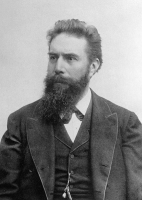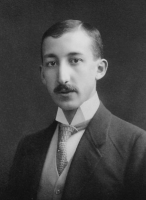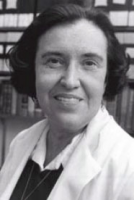The Long-Lived History of Nuclear Medicine
When was the marriage between radiation and medicine?
At first glance, joining those two might seem counter-intuitive given the shaky public perception of nuclear. Yet, we've all had x-ray procedures. Some of us might have even been treated with a radioactive isotope. Every major hospital in the world uses a radioactive source or an accelerator for one reason or another - usually for therapy or sterilization. Accelerators, nuclear reactors, and national laboratories across the US are working overtime to deliver isotopes for cancer research. It's a billion-dollar industry that's growing with new medicines and new treatments every year. How did that all start?
Nuclear power plants had their kick-off with Enrico and CP-1; there's also the other path formed by Oppenheimer, Groves, and the Manhattan project. But before those two pillars of nuclear engineering took main stage, there was a third application building underneath. In the early 20th century, the atom's newly discovered secret was aimed at a problem that's older than electricity: cancer's 1 in 4 deadly touch. And just like any other technology, nuclear medicine went through periods of trial and error. Back then the rules of experimental research were different - dangerously different. So if you thought the Manhattan Project has all the good stories, strap in, clip on your dosimeter, and take a trip down nuclear medicine's memory lane.

Wilhelm Roentgen
We start with Wilhelm Roentgen - a professor at the University of Wurzburg in central Germany. Tall, slender, and bearded, Roentgen discovered that using cathode tubes he could generate invisible rays that drive at the speed of light. Through an ungodly amount of experimentation and dose, he discovered that the only thing that could stop these powerful rays were sheets of metal. His wife - Anna Bertha - grew exceedingly annoyed with all the commotion going on in the basement laboratory. In what was probably an effort to smooth the tension, he invited her to the lab, placed her hand on a photographic plate, and zapped it with the invisible rays for 15 minutes! The result was the world's first x-ray that's printed in just about every radiation textbook across the world. You've probably seen it: the bones, the fleshy outer layers, and the famous ring on the left hand. Wilhelm was ecstatic. Anna, not so much, who's rumored to have screamed: "I have seen my death!"
In a state of shock, excitement, and confusion by this discovery, Roentgen called these rays by the universal unknown variable: x. It wasn't before long that x-rays took off and became a staple in medicine (it was actually only 8 weeks after Roentgen's discovery). Not only could the invisible rays diagnose broken bones, they could also destroy cells at a highly concentrated level. This convenient fact was discovered when a grad-student at the Medical College in Chicago noticed blisters on his hands while working with cathode tubes. After showing the blisters to his professor, the department decided to try x-rays on a breast-cancer patient named Rose Lee who - at the time - was diagnosed as hopeless. After some experimental trials, Rose's tumors started to shrink. The year was 1898 and the first external radiotherapy facility was now in play. Today, external radiotherapy is a major workhorse in the treatment in early stage breast cancer and small tumors. And the grad-student? He had to have that blistered hand amputated from too many unshielded x-rays.
Not long after, it was Henri Becquerel that discovered we don't need cathode tubes to generate invisible rays. Turns out Nature gave us an ample supply in the form of unstable nuclei. Some of our more heavy-set atoms are looking to shed a few protons and neutrons and consequently, we've been blessed with radioactivity. To that end, no nuclear medicine article is complete without the Curies.
Nobel prizes in chemistry aside, Madame Curie was an engineer at heart. While she and her husband were unveiling the periodic table's hidden characters, she was also concerned how this new radioactive toy could be useful. Of course, she's known for using radium's photons to help soldiers during WWI. But after discovering radiation burns on their hands, the dynamic duo realized radium packed a punch that might be useful against cancers. And so was born Curie-therapy: take a sharp feather pen, soak it in your house-hold stock of glowing radium dichloride, and stab it right into the middle of a tumor. If that doesn't work, add more radium. In 1904, the physician John MacLeod assembled the first radium applicator in London for treating internal tumors. Radium was now in medicine's tool box.
Sound crazy? Well it's not that much different than what's used today. The Curies set the stage for brachytherapy: a goliath world-wide practice that treats hundreds of thousands of patients per year in the form of slightly radioactive seeds. Granted, the radium is more contained in a glass or gold seed implant. Still though, we can't ignore those odd years when radium was used as eye-liner, toothpaste, or hair dye.

George Hevesy
Ever been frustrated with cafeteria food? Ever been so frustrated that you contaminated the whole cafeteria with radioactivity just to prove a point? Meet George Hevesy, a Hungarian chemist that studied under Manchester's Ernest Rutherford. Around 1930, George was studying the chemistry of radioactive tracers such as radium, lead, and bismuth. Tracers - though too small to visibly see - still give off a powerful signal detected by even the simplest of detectors.
Overzealous, young, broke, and living the grad-student lifestyle, George had a feeling that his dormitory cafeteria was re-using meat. For example, when a hamburger was served on a Monday, beef goulash was suspiciously served on Tuesdays and so forth. After confronting the cafeteria staff proved futile, George equipped himself with E = mc^2 for the ultimate forensics evidence in cafeteria battles. One Monday, George ordered the hamburger and returned a large unfinished portion of leftovers back to the cafeteria. That hamburger, however, was spiked with a potent radioactive secret. The next day, when the cafeteria was conveniently serving beef goulash, George brought along a new instrument that "clicked" around radioactive elements (borrowed from his lab partner Hans Geiger). Standing within a few feet of the beef goulash, the counter went berserk: click-------click-----click--click-clickclickclickclickclick; proving that the radioactivity from the burger had somehow made its way into the kitchen's beef recycle loop.
Setting the liabilities aside, it was that frame of mind that led to a major tool used in nuclear medicine: internal radiotherapy. In addition to tracking a cafeteria kitchen, radioactive isotopes can also map biological systems. George went on to spike other things with tracers - plants and small animals mainly. He discovered that our bodies will process tracers just like any other element. So, if you were spiked with a tiny amount of radioactive lead, a certain percent might go to the kidney, another percent will deposit in bone, another percent stays in the blood - but those organs would now fire off lead's powerful signature radiation. And by adjusting the chemistry of the tracer, a higher percentage can be driven to different organs and so forth. Born was the now widely practiced technology of internal radionuclide diagnostics and therapy used to treat heart diseases and tumors!
As the harmful effects of un-controlled radiation were realized, R&D became more constricted to the laboratory. Radioactive isotopes then targeted a new problem in medicine: diabetes. Up until the 1960s, diabetic patients were given "cattle insulin" to regulate their blood sugar. Cattle insulin is exactly what it sounds like - massive amounts of cattle pancreas were harvested for their insulin and prescribed to diabetics. But something strange was going on during clinical trials: diabetic patients had more insulin in their blood than healthy patients. That doesn't make sense? Diabetics usually don't produce enough insulin to maintain blood sugar levels. So why did these patients have more insulin than normal?

Rosalyn Yalow
Enter Rosalyn Yalow, a radiochemist out of New York. She and Soloman Berson teamed up to put radioactive iodine to work. By tagging insulin with radioactive iodine tracers, she was able to track the insulin and the radioactivity as it was processed by the body. What she discovered was that the body was attacking the cattle insulin with antibodies. After all, cattle insulin isn't supposed to be there in the first place! Antibodies weighed down the insulin and rendered it ineffective. Long story short, cattle insulin doesn't really work on humans. Today's insulin is modified to reflect "human" insulin as a result of these radioactive iodine experiments. Rosalyn was later awarded the Nobel Prize for developing the concept of radioimmunoassay.
Nuclear medicine is an amazing story that slowly progressed through experimental trials - and still does today! Although nuclear medicine doesn't have the flashy bang from the trinity site, or the inspiring, heroic ingenuity from CP-1, a good number of those nuclear legends were in the medicine field too. Earnest Lawrence (who invented the uranium enriching calutron) used his Berkeley cyclotrons to irradiate tumors and produce isotopes. Glenn Seaborg (who discovered plutonium) also discovered Tc-99m: the most important medical isotope in the world. And when Leo Szilard (who discovered the chain reaction) was diagnosed with bladder cancer in 1959, he brought his own radioactive isotopes to the hospital for self-diagnosis and treatment.
The atom's nucleus holds an incredible stockpile of energy and upon that discovery our recorded history suggests that scientist's first instinct wasn't to produce electricity, nor was it weapons. Rather, it was medicine. And though things got contaminated back then, consider this: Marie Curie chose not to patent her radium chemistry. She and her husband published everything in open journals. Shortly thereafter, radium went viral and is still used in almost every major hospital today - the profits of which never went to the Curies. The element grew so popular that Marie joked that she couldn't afford to buy it anymore. To me, it's a reminder that humans first engineered E = mc^2 to understand our bodies, to help the wounded, to cure diseases, and the creativity behind nuclear scientists and engineers.
References
Thank you J.M.B. for your contributions and edits.
- Nelson, The Age of Radiance, Scribner, NY, 2014.
- Kean, The Disappearing Spoon, Little, Brown, & Company, NY, 2010.
- Kang, N. Pedersen, Quackery: A Brief History of the Worst Ways to Cure Everything, Workman Publishing Company, NY, 2017.
https://www.chemistryworld.com/opinion/it-belongs-to-the-people/7420.article
https://www.sciencehistory.org/historical-profile/rosalyn-yalow-and-solomon-a-berson
Feel free to leave a constructive remark or question for the author in the comment section below.

